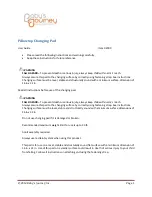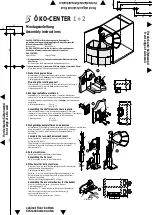
The graph (Figure 1) shows the way in which the gyro gain channel provides both mode switching and
independent gain adjustment of the two modes. If the gyro gain channel pulse is longer than the centre
value (1.5ms) the gyro is in Standard mode while with the gain channel pulse shorter than 1.5ms the
gyro is in Heading Lock mode. The Travel Volume (ATV) settings for the two switch positions provide a
convenient way of adjusting the gyro gain for each mode from the transmitter. Increasing the ATV of the
gyro gain channel increases the gain for that mode. If it is being used with a basic radio system without
a suitable channel for controlling the gyro gain then the gyro will run as a single rate unit with gain
adjustable from the manual gain control on the unit itself. In this case the gyro defaults to the Standard
mode.
100%
1.5ms
0%
1ms
2ms
Flight Mode 0
Flight Mode 1
Gain channel pulse length
Gain
(Standard Mode)
(Heading Hold Mode)
Increasing gain
Increasing gain
First Switch Position
Increasing gain channel ATV
Increasing gain channel ATV
Second Switch Position
Gyro
Figure 1.
The Gyro gain channel acts as both gyro mode switch and gain control
Installation.
Siting of the gyro.
Axis of rotation
(keep this parallel with main shaft of helicopter)
Attach to helicopter using two of the self-adhesive foam strips provided
COMPUTER
AUX. INPUT
REVERSE
SERVO
Rx 1-4 IN
Figure 2.
Mounting the gyro
The ICG 360 should be mounted in the helicopter with its axis of rotation (as marked on the gyro case)
accurately parallel to the main shaft of the helicopter. The gyro sensor (together with the electronics of
the gyro) is anti-vibration mounted inside the gyro case. However, to provide further vibration and shock
resistance it is important that the gyro be mounted to the airframe using two of the double sided
adhesive foam strips provided. Do not use any other type of mounting foam as this will reduce the
performance of your gyro. Replacement strips are available as a CSM spare. The gyro case may be
aligned along or transverse to the length of the helicopter. For good adhesion, ensure that the surface to
which the gyro is attached is smooth, hard and clean. As with all high performance solid state gyro
systems, the ICG360 performs best if sited at a point of low vibration in the helicopter airframe. Where
possible avoid siting the gyro at the extreme front of the radio tray for example as this area is often
subject to high levels of main rotor generated vibration.
Note:
Tests suggest that the X-Cell plastic radio
tray may be too flexible and that better performance can be gained by mounting the gyro at the rear of
the frames.


























